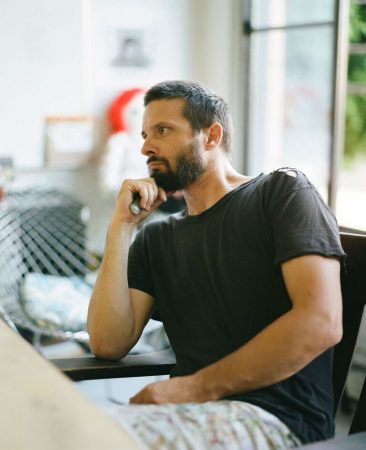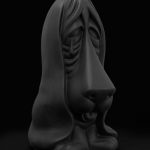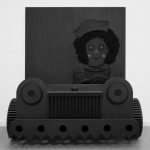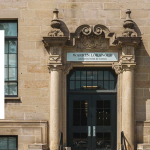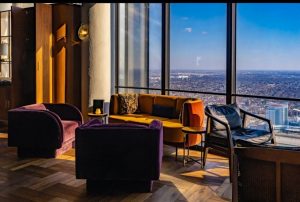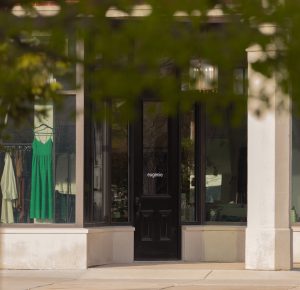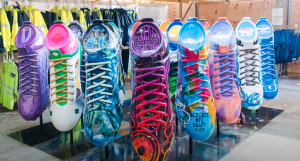“I hope it’s agonizing. That’s where the good shit comes from.”
This is Jason Yate’s response when I tell him I’m about to tear out all my hair writing this introduction. Writing and pulling and pacing. I can’t imagine Yates pulling his hair out, but he does have a certain anxiety that manifests as a pushiness to get things done. An intensity. He’s quick to respond—in person, in email, in text. And has an opinion on everything. Even if it’s “I don’t know.”
He’s the kind of person you can trust to always tell you how it is.
We’re on the roof of the NOMAD Hotel. Not because we’re that posh, but because it’s in close proximity to his new “grandfathered” studio. Artist spaces DTLA, like Downtown Detroit, are quickly becoming legend. Time and time again, when asked why he moved to LA, Yates has said: “I’d rather be broke on the beach.” When thinking of my own move, I want to say “I’d rather be broke on the roof of the NOMAD hotel,” but that seems obviously problematic.
Strikingly so, when we’re back on the sidewalk, being asked for change by one of Skid Row’s homeless, whose population seems to be multiplying as swiftly as the real estate prices down here. Yates, is genuinely agitated: not by the woman asking for change but by the callousness of Angelenos to treat homeless like trash—avoiding eye contact, pretending not to hear—and the ascent into a cashless society that takes away these panhandler’s ability to survive—”give them credit card readers.”
It’s not that Yates is an elevated person or has radical solutions, but he takes everything to heart—and into consideration. When talking of Detroit, he’s aware of his privileged perspective and is quick to note that his piece of Detroit history represents a small collection of stories from the city’s painfully complex history. In a way that’s almost debilitating.
His acute perception of surroundings makes for a perpetual sense of simultaneous ease and discomfort.
He can be prickly, and, yes, at times, he can come off as aggressive or boastful in certain regards, but the later always seem to be tied to a story, a recounting of what we did, whether the other part of that we is George Clinton or his lifelong friend and artist, Patrick Hill.
He is always raising up others.
During our ongoing conversations, the closest thing he mentions to his life as an artist is the anxiety he felt around his Wasserman show, “Homemade Ice Cream,” of creating a body of work for his hometown. Nothing about studying with Mike Kelley or his place in the Whitney Biennial or current shows or the fact that despite his own ambivalence, he has maintained a place in the art world for 20+ years where the average career span of a painter is something like four years.
So here we are, on the roof of a downtown hotel, the stars above and an expanse of couch between us. He’s telling me stories from Detroit and lamenting the loss of a time and place. That’s the thing with cities: they change. The Detroit he knew is almost gone, the Detroit I know is leaving. But it will always be home for both of us.
As for LA, “You will always be a tourist in this city.”
The following interview was conducted by email. It is for the most part unedited. What it presents is a small period in Detroit’s history, over a relatively brief period of time, and the origins of a great artist.
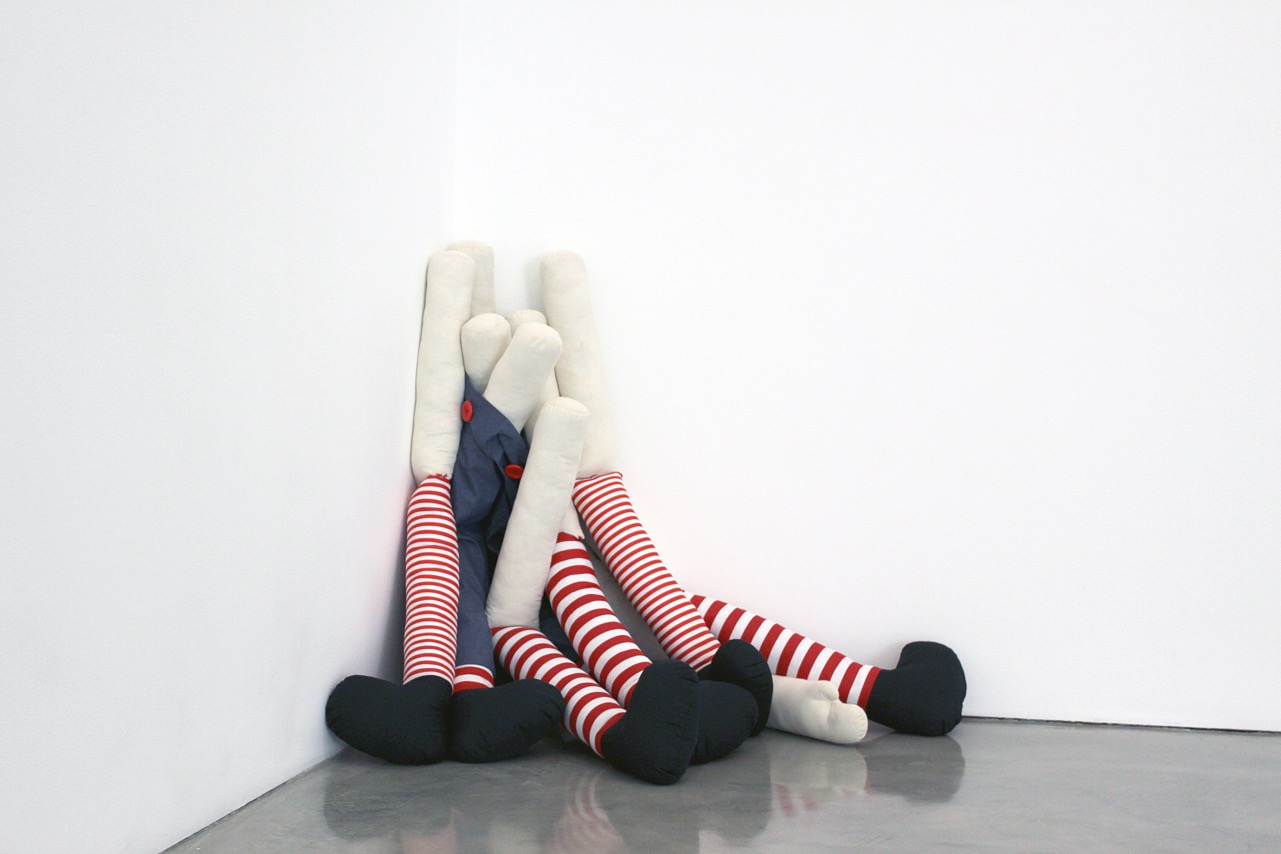
Friends Forever. Photo Jason Yates Studio
CV Henriette: Sun sign?
Jason Yates: Cancer.
CVh: Favorite Color?
JY: The entire spectrum all at once.
CVh: Favorite material?
JA: The nice ones.
CVh: Starting from the very beginning. When did you know you were an artist or wanted to be an artist?
JY: Probably during puberty. My Mom found No Doz and cigarettes in my room in 8th grade and freaked out. It was 1985 and Just Say No was peaking. She wanted the names of the other kids I was using with and when I wouldn’t give them up, she called the parents of ALL my friends. Ironically, the next day at school I was labeled a narc. Suddenly I had no friends and sat at a table in the lunch room alone. No one would sit with me. After lunch I went in the gym to shoot baskets by myself and the entire 8th grade came in, sat on the bleachers, and heckled me. I eventually ran out of the gym crying and about 20 of them chased me all the way to the office. Fucking cannibals! I was now an outcast and I had a lot of time to myself. So, I sat around drawing vampires, reading comic books, and listening to The Butthole Surfers. In retrospect, the rejection by my peers was crucial.
CVh: Was your family supportive?
JY: Yes. They certainly didn’t discourage me. It wasn’t so unusual in my family. My Mom studied art at Oakland University, my Dad studied cabinetry at Northwood, and my Uncle went to Kendall College of Art and was a staff illustrator at Creem Magazine in the early 70’s.
CVh: Who were some of your earliest mentors?
JY: Bill Tall. He was my high school art teacher. He had a glass eyeball and pug like features. He let me smoke cigarettes with him in his office, and when I had in-school suspensions, he would get permission for me to spend the entire day in the art room. I got suspended a lot. He encouraged me and told me that if sex and drugs don’t kill me, that I could succeed as an artist. I think I was 13 the first time he said this to me. He also turned me on to all the relevant galleries in and around Detroit. He also introduced me to the music of Kate Bush, Maria Callas, and Tangerine Dream. It seemed like The Hounds of Love could always be heard playing loudly through his office door. The art room became a sanctuary for me and my friends. Bill Tall fostered that.
CVh: What inspired your move to Detroit?
JY: I hated the suburbs. To me, it had no soul. Pat Hill, Roe Peterhans, and I would skip school and drive downtown and explore the city. We would go to the DIA and walk around Harmony Park. I eventually received a scholarship during my junior year in high school to study at CCS on Saturdays. Roe would pick me up and we would smoke and talk excitingly and listen to music on the drive downtown. Through our instructor Sally Kaplan, I met the painter Stephen Goodfellow and members of Propeller Studio. They were all living in one of Joel Landy’s buildings on Forest that was eventually devoured by the hospital expansion. It was quite a scene for the 16 year old me.
I think Roe and I dropped a little acid before going to a tutorial at Stephen’s studio on micro-pointalism on one such Saturday. Our minds were blown. I felt free in Detroit. I also felt some degree of acceptance in that community, even though I was much younger than any of them. It wasn’t long before I started sneaking into clubs like The Warehouse, Blondies, United Shirt, and The City Club.
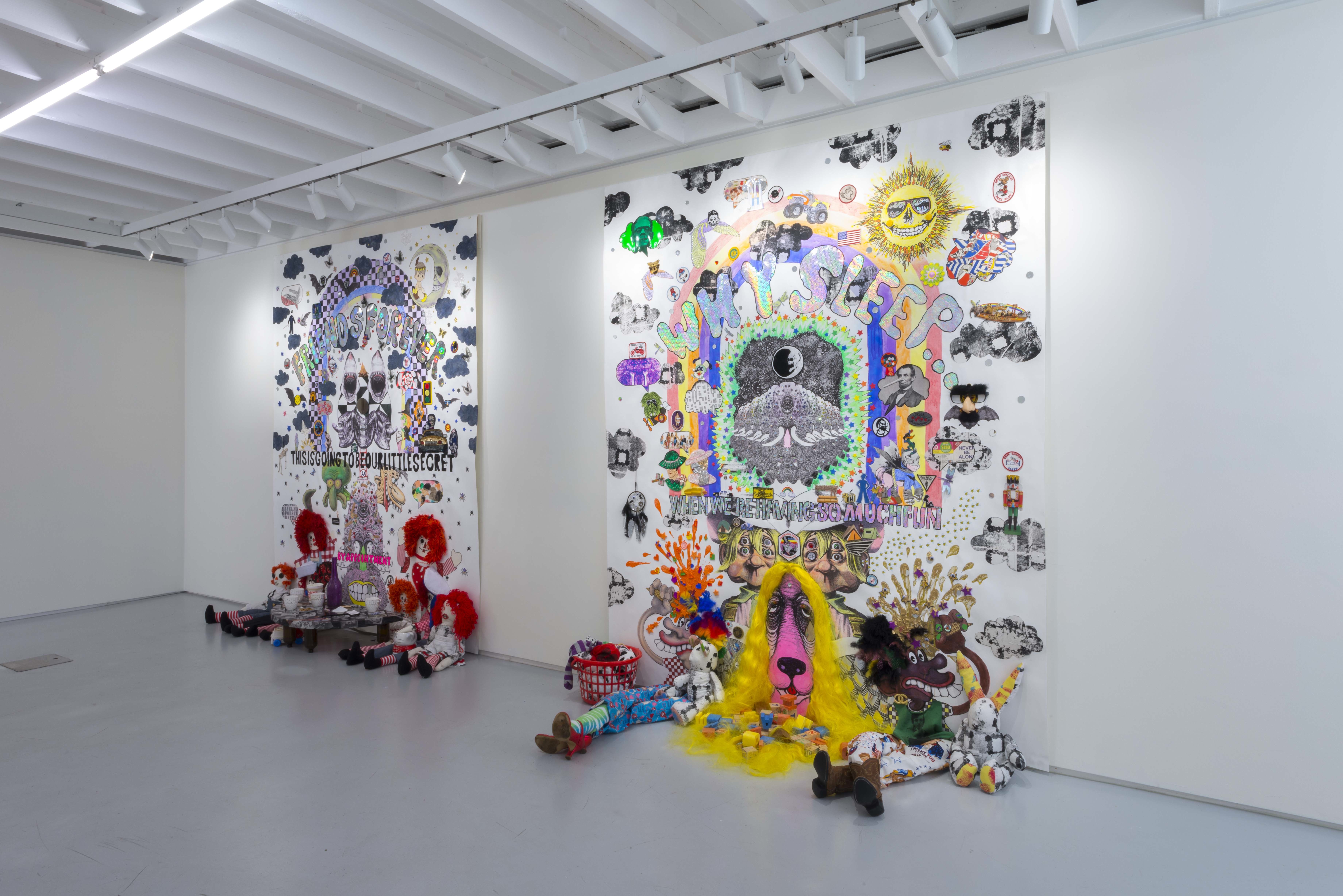
From the show Did I Stutter, Did I Ever. Photo Josh White for C Nichols Project
CVh: Tell us about the Detroit you know—How’d it look? Who was there? What was happening?
I had my first studio in Detroit around 1992, on the top floor of 1 John R. I shared it with Hobey Echlin and Michael McGillis. It was a beautiful space, with windows wrapping all around John R to Woodward and punctuated by a parapet designed for musicians to give recitals to what was once a bustling intersection. The Hudsons Building—where my Grandmother worked as a teen—was still standing.
Looking south on Woodward, the store fronts were mostly wig shops. The Woolworths still served food. A block to the north was The State Theater and then the Fox. Later, I moved into the Marks Fur Building on Capital Park. For me, as a young artist, I thought it was paradise.
The population downtown was a minute fraction of what it has now become, when I was there in the early 90’s. All that empty infrastructure and raw material created a lot of possibilities. The governing municipalities couldn’t manage the majority of Detroit. There was a sense of anarchy downtown and in the Cass Corridor at that time. Traffic lights were optional and parking tickets were non existent. For people like me, it made way for a lot of personal freedom and experimentation. I had that privilege.
Detroit was very analog and resisted or—simply had no access to—new technologies. Its current aesthetics and branding still feel deeply nostalgic for the pre-digital age. There’s a kind of blue collar dandyism that seems to resonate throughout its culture. I remember being exposed to The Weekly Reader back in elementary school in the late 70’s, and there was an article about automated assembly and robots as this great new innovation. I doubt it was the periodicals intention, but this was a terrifying glimpse into the not too distant future for the working class, a final death blow. For all of its technological innovation in production and automation, one of the things people seem to absolutely romanticize about Detroit is a nostalgia for the craftsperson and handcrafted.
There weren’t many resources for artists back then. No substantial grants and not many galleries. The suburbs were a long way from supporting Detroit’s artistic community. You had to learn how to cross pollinate disciplines and hustle. I always felt like Matt Blake was a great example of this. He made paintings, furniture, designed interiors for clubs and restaurants, played drums in several bands. I should also mention that he was absolutely hilarious. Matt was great mentor and I really admire him to this day.
Matt Blake was one of the many great personalities and stone characters I remember: Def Steph, Jerome Ferretti, Niagra and The Captain, Matt Alonso, Rico Africa, Hysterica, Tyrone, Jake The Snake, Tricky Dick, Joel Landy, Rhonda Jackson, Rachel Nagy, Preston Long, Chris Turner . . . on and on. They all seemed to congregate at Union Street. I could drink underage there and years later, when I finally had my 21st birthday there, the management was not so amused. David Michael was the bartender for years, and he let just about anything fly as long as it was fun and no one died. I’ve danced naked to Prince on that bar. I was typically dirt poor and always walked out with a full head and stomach.
You really had to royally fuck up to burn a bridge. Not everyone liked each other, but people respected one another. I have many fond memories of that time—but would be lying if I didn’t mention the multiple times I was robbed and assaulted or showering with a garden hose on a fire escape in February. My loft on Capital Park had no heating or cooling or water, and we had to steal electricity from a light pole outside. I was basically squatting. During the winter I would set up a tent and run a space heater inside to stay warm. Late fall through early spring the conditions could be brutal and scarce. I can’t say that I really miss that.
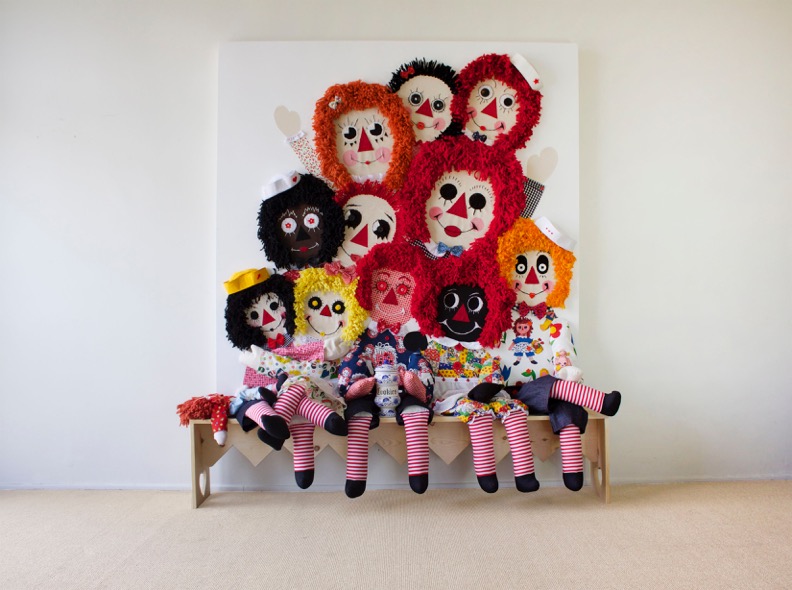
Smile Everyone. Photo Jason Yates Studio
CVh: As a young artist from the suburbs, did you ever feel a tension with people who had been in the city longer?
JA: I assume that you are referring to gentrification. No. Not in any significant sense. I was living there at a time when the population had really dipped. That critique didn’t really exist at that point in time. Quite the opposite. The city was still in the grips of the fall out caused by the auto companies out-sourcing labor and production to foreign countries, which absolutely fueled the economy of crack and the new face of slavery. The suburbs profited from that decline, much in the same way the suburbs are now profiting from its economic revival.
How much have Detroit’s schools improved over the past decade? That’s true infrastructure. How can we can talk about all the “great things” happening in Detroit when the public schools are in evidence of this so-called rebirth. LA has the same problems. I think most people are tired of hearing how “complicated” this issue is. If there is a higher priority for the future of Detroit, I’d love to hear it.
I suppose there will always be a More Detroit Than You attitude, but people leaving the suburbs to live in Detroit in the 80’s and 90’s was an anomaly. The suburbs suffered from a deep bigotry and segregated themselves for decades. The last time I was in town I saw white kids walking down Cass with yoga mats under their arms, and it blew my mind. When I was growing up, parents would tell their children not to go into the city, that it was “dangerous”. I knew early on that attitude was total bullshit. Detroit had soul and that’s where I wanted to be.
CVh: You left Detroit for LA for, presumably, better opportunities. What did LA offer that Detroit couldn’t?
JY: I guess I’d rather be poor at the beach.
It’s important to note that the LA I moved to over 20 years ago is long gone, much like the part of Detroit I left is gone. I was able to secure student loans for graduate school in LA and be given the opportunity to back door LA’s art community in this way. I jumped at the chance to work with some of my heroes.
I’m restless now—like I was then. Los Angeles seemed like someplace I could evolve, and I was right. Pre-Internet Detroit was a place with few financial resources. I felt like I hit a brick wall and the 2D sky was killing me. Los Angeles seemed to be a continual ejaculation of resources. I knew just about everyone in Detroit. That got old for me, and I’m sure I got old to people there, too. I was admittedly pretty feral. Los Angeles seemed like an alien planet where all my fantasies and nightmares could come true. I love a good cliché. Now I live in one.
The LA I moved to is very different from the LA I live in now. There isn’t as much room for risk or experimentation. This wouldn’t be the place I’d move to and try and make art in at this point in time. I’ve made peace with it, because—for so many reasons—I can’t leave.
The game has changed in all artistic endeavors. It’s now a “career” choice, which is such a strange attitude to have. There simply isn’t much room left in the arts for social misfits and runts. There are only so many slots, and if you don’t have your “shit together”, you’ll find yourself overlooked or labeled as “difficult.” It’s very competitive. I don’t think the same could be said for Detroit right now. I see people taking interesting risks there and different people are doing things in Detroit that would either never fly in LA, or simply wouldn’t be possible. Detroit is super fertile in this way. It always has been. The cost of living is a fraction of what it costs to live in LA. It just seems like there are far more opportunities and resources in Detroit than when I lived there. You can travel and come home to a building you actually own. When you visit LA, you’ll find yourself very popular. When you move here, you become competition.
CVh: Who are some of the artists taking interesting risks in Detroit right now?
JY: I am pretty excited by the galleries in Detroit. Pipeline and Bahamas Biennale have interesting programming. They both seem to operate with a great amount of intellectual freedom. Also, I really liked the students and the fine arts program at Wayne State. CCS is very different than when I was a student there. It has improved immensely. I really enjoyed visiting both programs and had very positive experiences. The students I encountered there were very serious and many were already making very sophisticated work. I like Chris Riddell’s work. He’s a serious weirdo, and I mean that as a compliment.
CVh: What’s your advice to young artists in LA?
JY: Please don’t take my advice.
CVh: You recently moved into a new studio. You’re still making art. What are you working on next?
JY: I’m working on a show curated by Charlie Fox that opens in London next year called Dracula’s Wedding. My goal is to show a lot less, to make less work. I want to take my time and make work because I want too, not because I have a show. I’ve never been able to do that before. I need to eliminate the stress and form good professional relationships. I don’t have time for the caca love.
Two of the works featured above, “Restless Feeling By My Side” and “Please Don’t Ever Leave Me” are from Yates solo show, Homemade Ice Cream, at Wasserman Projects in Detroit, Michigan.


